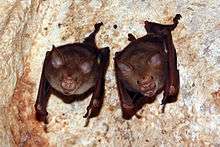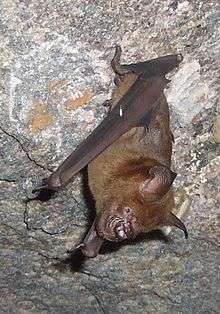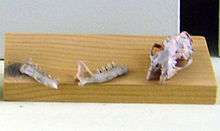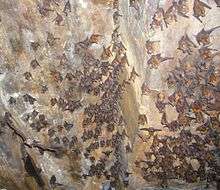Hipposideridae
The Hipposideridae are a family of bats commonly known as the Old World leaf-nosed bats. While it has often been seen as a subfamily, Hipposiderinae, of the family Rhinolophidae, it is now more generally classified as its own family.[1] Nevertheless, it is most closely related to Rhinolophidae within the suborder Yinpterochiroptera.[2]
| Hipposideridae Temporal range: Eocene to present | |
|---|---|
 | |
| Commerson's leaf-nosed bat (Hipposideros commersoni) | |
| Scientific classification | |
| Kingdom: | Animalia |
| Phylum: | Chordata |
| Class: | Mammalia |
| Order: | Chiroptera |
| Superfamily: | Rhinolophoidea |
| Family: | Hipposideridae Lydekker, 1891 |
| Genera | |
|
See text | |
| Synonyms | |
Taxonomy
The Hipposideridae contain 10 living genera and more than 70 species, mostly in the widespread genus Hipposideros.[3] In addition, several fossil genera are known; the oldest fossils attributed to the family are from the middle Eocene of Europe.[4] In their 1997 Classification of Mammals, Malcolm C. McKenna and Susan K. Bell proposed a division of Hipposideridae (called Rhinonycterinae in their work) into three tribes, one with two subtribes,[5] but these tribes turned out to be non-monophyletic and have been abandoned.[1] A different classification was proposed by Hand and Kirsch in 2003.[6] In 2009, Petr Benda and Peter Vallo proposed a separate tribe, Triaenopini, for the genera Triaenops, Paratriaenops, and possibly Cloeotis,[7] synonymised in a 2014 revision (Foley, et al.) that elevated the family Rhinonycteridae.[8]
Genera
The genera included in Hipposideridae are:[9]
Living
- Anthops (one species; Solomon Islands and Bougainville Island)
- Asellia (four species; Africa and southwestern Asia; Miocene fossils from Europe)
- Aselliscus (three species; southeastern Asia and Melanesia)
- Cloeotis (one species; Africa)
- Coelops (at least two species; southeastern Asia; Miocene fossils from Africa)
- Hipposideros (more than sixty species; Africa, southern Eurasia, and Australasia; oldest fossils from the Eocene of Europe; includes Pseudorhinolophus, sometimes considered a separate genus)
- Macronycteris (five species, Africa and Madagascar)
- Paracoelops (one species; Vietnam)
- Paratriaenops (previously included in Triaenops; three species; Madagascar and Seychelles)[10]
- Rhinonicteris (one extant species; Australia; earliest fossils from the Miocene)[11]
- Triaenops (four species; Africa and southwestern Asia)[10]
Extinct
- Brachipposideros (Oligocene to Miocene of Europe and Miocene of Australia; sometimes included in Hipposideros)
- Brevipalatus (Miocene of Australia)[12]
- Archerops (Miocene of Australia)[13]
- Miophyllorhina (Miocene of Australia)[11]
- Palaeophyllophora (Eocene to Miocene of Europe)
- Paraphyllophora (Eocene or Oligocene to Miocene of Europe)
- Riversleighia (Miocene of Australia)[11]
- Vaylatsia (Oligocene of Europe)[14]
- Xenorhinos (Miocene of Australia)[11]
List of species



- Family Hipposideridae — Old World leaf-nosed bats
- Genus Anthops
- Flower-faced bat, Anthops ornatus
- Genus Asellia — trident leaf-nosed bats
- Arabian trident bat, Asellia arabica[15]
- Somalian trident bat, Asellia italosomalica[15]
- Patrizi's trident leaf-nosed bat, Asellia patrizii
- Trident bat, Asellia tridens
- Genus Aselliscus — Tate's trident-nosed bats
- Stoliczka's trident bat, Aselliscus stoliczkanus
- Temminck's trident bat, Aselliscus tricuspidatus
- Genus Cloeotis
- Percival's trident bat, Cloeotis percivali
- Genus Coelops — tailless leaf-nosed bats
- East Asian tailless leaf-nosed bat, Coelops frithii
- Philippine tailless leaf-nosed bat, Coelops hirsutus
- Malayan tailless leaf-nosed bat, Coelops robinsoni
- Genus Hipposideros — roundleaf bats
- Aba roundleaf bat, Hipposideros abae
- Great roundleaf bat, Hipposideros armiger
- Dusky roundleaf bat, Hipposideros ater
- Benito roundleaf bat, Hipposideros beatus
- Boeadi’s roundleaf bat, Hipposideros boeadii
- Bicolored roundleaf bat, Hipposideros bicolor
- Short-headed roundleaf bat, Hipposideros breviceps
- Sundevall's roundleaf bat, Hipposideros caffer
- Spurred roundleaf bat, Hipposideros calcaratus
- Greater roundleaf bat, Hipposideros camerunensis
- Fawn leaf-nosed bat or fawn roundleaf bat, Hipposideros cervinus
- Ashy roundleaf bat, Hipposideros cineraceus
- Large Mindanao roundleaf bat, Hipposideros coronatus
- Telefomin roundleaf bat, Hipposideros corynophyllus
- Cox's roundleaf bat, Hipposideros coxi
- Timor roundleaf bat, Hipposideros crumeniferus
- Short-tailed roundleaf bat, Hipposideros curtus
- Cyclops roundleaf bat, Hipposideros cyclops
- Makira roundleaf bat, Hipposideros demissus
- Diadem roundleaf bat, Hipposideros diadema
- Fierce roundleaf bat, Hipposideros dinops
- Borneo roundleaf bat, Hipposideros doriae
- Khajuria's leaf-nosed bat, Hipposideros durgadasi
- Dayak roundleaf bat, Hipposideros dyacorum
- Hill's roundleaf bat, Hipposideros edwardshilli
- Hipposideros fasensis
- Sooty roundleaf bat, Hipposideros fuliginosus
- Fulvus roundleaf bat, Hipposideros fulvus
- Cantor's roundleaf bat, Hipposideros galeritus
- Grand roundleaf bat, Hipposideros grandis
- Thailand roundleaf bat, Hipposideros halophyllus
- Kolar leaf-nosed bat, Hipposideros hypophyllus
- Crested roundleaf bat, Hipposideros inexpectatus
- Arnhem leaf-nosed bat, Hipposideros inornatus
- Jones's roundleaf bat, Hipposideros jonesi
- Phou Khao Khouay leaf-nosed bat, Hipposideros khaokhouayensis
- Khasian leaf-nosed bat, Hipposideros khasiana
- Lamotte's roundleaf bat, Hipposideros lamottei
- Indian roundleaf bat, Hipposideros lankadiva
- Intermediate roundleaf bat, Hipposideros larvatus
- Large Asian roundleaf bat, Hipposideros lekaguli
- Shield-faced roundleaf bat, Hipposideros lylei
- Big-eared roundleaf bat, Hipposideros macrobullatus
- Maduran leaf-nosed bat, Hipposideros madurae
- Maggie Taylor's roundleaf bat, Hipposideros maggietaylorae
- Aellen's roundleaf bat, Hipposideros marisae
- Ethiopian large-eared roundleaf bat, Hipposideros megalotis
- Fly River roundleaf bat, Hipposideros muscinus
- Malayan roundleaf bat, Hipposideros nequam
- Philippine forest roundleaf bat, Hipposideros obscurus
- Orbiculus leaf-nosed bat, Hipposideros orbiculus
- Biak roundleaf bat, Hipposideros papua
- Hipposideros parnabyi
- Peleng leaf-nosed bat, Hipposideros pelingensis
- Pomona roundleaf bat, Hipposideros pomona
- Pratt's roundleaf bat, Hipposideros pratti
- Philippine pygmy roundleaf bat, Hipposideros pygmaeus
- Ridley's leaf-nosed bat, Hipposideros ridleyi
- Laotian leaf-nosed bat, Hipposideros rotalis
- Noack's roundleaf bat, Hipposideros ruber
- Hipposideros scutinares
- Semon's roundleaf bat, Hipposideros semoni
- Sorensen's leaf-nosed bat, Hipposideros sorenseni
- Schneider's leaf-nosed bat, Hipposideros speoris
- Northern leaf-nosed bat or narrow-eared roundleaf bat, Hipposideros stenotis
- Sumba roundleaf bat or Sumban leaf-nosed bat, Hipposideros sumbae
- Hipposideros tephrus
- Lesser great leaf-nosed bat, Hipposideros turpis
- Wollaston's roundleaf bat, Hipposideros wollastoni
- Genus Macronycteris[16]
- Commerson's leaf-nosed bat or Commerson's roundleaf bat, Macronycteris commersoni
- Macronycteris cryptovalorona[17]
- Giant roundleaf bat, Macronycteris gigas
- Saõ Tomé leaf-nosed bat, Macronycteris thomensis
- Striped leaf-nosed bat, Macronycteris vittatus
- Genus Paratriaenops
- Grandidier's trident bat, Paratriaenops auritus
- Trouessart's trident bat, Paratriaenops furculus
- Paulian's triple leaf-nosed bat, Paratriaenops pauliani
- Genus Rhinonicteris (also treated as monotypic family Rhinonycteridae Gray, 1866.)[18]
- Orange leaf-nosed bat, Rhinonicteris aurantia
- Rhinonicteris tedfordi, an early Miocene species[18]
- Genus Triaenops — triple leaf-nosed bats
- Triaenops afer
- Triaenops menamena
- Triaenops parvus
- Rufous trident bat or Persian trident bat, Triaenops persicus (also known as Triaenops rufus)
- Genus Anthops
Notes
- This name technically has priority over Hipposiderinae Lydekker, 1891, and some have consequently used "Rhinonycteridae" or "Rhinonycterinae" for this (sub)family; however, Hipposideridae/inae has been in common use since 1907 and is currently retained pending action by the International Commission on Zoological Nomenclature.[1]
References
- Simmons, 2005, p. 365
- Hutcheon and Kirsch, 2006
- Simmons, 2005, pp. 365–379
- McKenna and Bell, 1997, p. 306
- McKenna and Bell, 1997, pp. 306–307
- Hand and Kirsch, 2003, table 3
- Benda and Vallo, 2009, p. 33
- Foley, Nicole M.; Thong, Vu Dinh; Soisook, Pipat; Goodman, Steven M.; Armstrong, Kyle N.; Jacobs, David S.; Puechmaille, Sébastien J.; Teeling, Emma C. (February 2015). "How and Why Overcome the Impediments to Resolution: Lessons from rhinolophid and hipposiderid Bats". Molecular Biology and Evolution. 32 (2): 313–333. doi:10.1093/molbev/msu329. PMC 4769323. PMID 25433366.
- Simmons, 2005, pp. 365–379; McKenna and Bell, 1997, pp. 306–307; other sources cited for specific genera
- Benda and Vallo, 2009, p. 34
- Archer et al., 2006, p. 7
- Hand and Archer, 2005
- Hand and Kirsch, 2003
- Ziegler, 2000, p. 652; Hand and Kirsch, 2003, table 3; cf. McKenna and Bell, 1997, p. 305 (excluded from Rhinonycterinae)
- Benda, Petr; Vallo, Peter; Reiter, Antonín (2011). "Taxonomic Revision of the Genus Asellia(Chiroptera: Hipposideridae) with a Description of a New Species from Southern Arabia". Acta Chiropterologica. 13 (2): 245–270. doi:10.3161/150811011X624749.
- Foley, N. M.; Goodman, S. M.; Whelan, C. V.; Puechmaille, S. J.; Teeling, E. (June 2017). "Towards Navigating the Minotaur's Labyrinth: Cryptic Diversity and Taxonomic Revision within the Speciose Genus Hipposideros (Hipposideridae)". Acta Chiropterologica. 19 (1): 1–18. doi:10.3161/15081109acc2017.19.1.001.
- Goodman, S. M.; Schoeman, M. C.; Rakotoarivelo, A.; Willows-Munro, S. (2016). "How many species of Hipposideros have occurred on Madagascar since the Late Pleistocene?". Zoological Journal of the Linnean Society. 177 (2): 428–449. doi:10.1111/zoj.12368.
- "Species profile: Rhinonicteris aurantia (Pilbara form) — Pilbara Leaf-nosed Bat". Species Profile and Threats Database. Canberra: Department of the Environment.
- Bibliography
- Archer, M., Arena, D.A., Bassarova, M., Beck, R.M.D., Black, K., Boles, W.E., Brewer, P., Cooke, B.N., Crosby, K., Gillespie, A., Godthelp, H., Hand, S.J., Kear, B.P., Louys, J., Morrell, A., Muirhead, J., Roberts, K.K., Scanlon, J.D., Travouillon, K.J. and Wroe, S. 2006. Current status of species-level representation in faunas from selected fossil localities in the Riversleigh World Heritage Area, northwestern Queensland. Alcheringa Special Issue 1:1-17. ISBN 0-9757894-5-7
- Benda, P. and Vallo, P. 2009. Taxonomic revision of the genus Triaenops (Chiroptera: Hipposideridae) with description of a new species from southern Arabia and definitions of a new genus and tribe. Folia Zoologica 58(Monograph 1):1–45.
- Hand, S.J. and Archer, M. 2005. A new hipposiderid genus (Microchiroptera) from an early Miocene bat community in Australia. Palaeontology 48(2):371–383.
- Hand, S.J. and Kirsch, J.A.W. 2003. Archerops, a new annectent hipposiderid genus (Mammalia: Microchiroptera) from the Australian Miocene. Journal of Paleontology 77(6):1139–1151.
- Hutcheon, J.M. and Kirsch, J.A.W. 2006. A moveable face: deconstructing the Microchiroptera and a new classification of extant bats. Acta Chiropterologica 8(1):1–10.
- McKenna, M.C. and Bell, S.K. 1997. Classification of Mammals: Above the species level. New York: Columbia University Press, 631 pp. ISBN 978-0-231-11013-6
- Simmons, N.B. 2005. Order Chiroptera. Pp. 312–529 in Wilson, D.E. and Reeder, D.M. (eds.). Mammal Species of the World: a taxonomic and geographic reference. 3rd ed. Baltimore: The Johns Hopkins University Press, 2 vols., 2142 pp. ISBN 978-0-8018-8221-0
- Ziegler, R. 2000. The bats (Chiroptera, Mammalia) from the Late Oligocene fissure fillings Herrlingen 8 and Herrlingen 9 near Ulm (Baden-Württemberg). Senckenbergiana Lethaea 80(2):647–683.